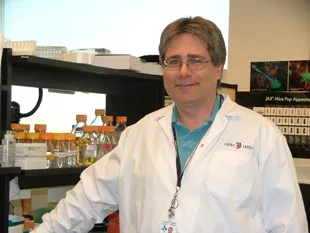Dr. Michel Chrétien Researcher of the Year Award 2012
Dr. David Picketts
Growing up, Dr. David Picketts always wanted to practice medicine, but that all changed with some lab work during his final undergraduate year at Queen's University in Kingston, Ontario. There he was introduced to working with recombinant DNA, manipulating and cloning bits of DNA. "I just loved it and I wanted to do that. I was hooked on research," says Dr. Picketts.
"I like to try to help people in the way that I can. I always thought that I'd like to apply science to health-related problems, and with genetics and disease-gene identification that still applied. So that's how I transitioned."
Dr. Picketts has translated these two passions into a track record of scientific excellence, providing major contributions to our understanding of how mutations in certain genes, called chromatin remodelling genes, can cause intellectual disabilities. Chromatin remodelling genes play a role in packaging DNA and determining which genes are active or inactive. In 1995 as a post-doctoral fellow at Oxford University, he helped to identify the gene responsible for a severe form of intellectual disability called ATR-X syndrome, which established the idea that damaged chromatin remodelling proteins can cause human disease.
Since arriving at OHRI in 1997, his focus has been to understand how chromatin remodelling genes normally work for brain development and how a single-point mutation can produce such complex disorders. One of his first questions to pursue was, "Are there other chromatin remodelling proteins that could cause other intellectual disabilities and disorders?"

Dr. Picketts was awarded the Chrétien Researcher of the Year Award for his discovery of a specific gene that activates brain stem cells — knowledge that could lead to therapies for regenerating and repairing damage in people who have suffered brain injuries and strokes.
Dr. Picketts identified Snf2l as a promising gene for this exploration. However, he was set back when he could not identify any mutations in patients whose intellectual disability mapped to the region on the X chromosome where Snf2l was located. Still, he could not shake the hunch that it was important for brain development. Because high levels of Snf2l are present in the brain, he said, "Let's make a mouse and knock out Snf2l. Maybe the result will point us in a direction we should look."
The resulting mouse appeared completely normal, but wasn't.
His team eventually observed that the heads were slightly larger than regular mice. It turns out that the brains of these modified mice are 35% larger, have more cells in certain areas of the brain and have more actively dividing brain stem cells.
Dr. Picketts and his team also found that Snf2l controls the expression of a gene called Foxg1, which is associated with the intellectual disability disorder Rett syndrome in some people. While the mutant mice have high levels of Foxg1 and large brains, people with Rett syndrome lack Foxg1 and have small brains. These findings were published earlier this year in the prestigious journal Developmental Cell.
“This research represents a fundamental advance in our understanding of how the brain develops, and it also has important practical implications,” says Dr. Picketts. “If we could identify drugs that regulate Snfl2 activity, these could potentially be used to stimulate neural stem cells to help regenerate and repair damage in people who have suffered brain injuries or strokes. We’re still at the early stages of this research, but the possibilities are very exciting.”
His next avenue of exploration will be informed by the fact that one-third of all autistic patients have larger brains and that Rett syndrome, another autism spectrum disorder, also involves Foxg1. He wants to find out whether Snf2l's fine tuning of Foxg1 levels may contribute to autism spectrum disorders.
The Ottawa Hospital is a leading academic health, research and learning hospital proudly affiliated with the University of Ottawa and supported by The Ottawa Hospital Foundation.


